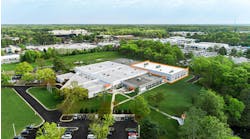Does the whole idea of the “Fourth Industrial Revolution,” aka, “Industry 4.0” make you dizzy? You’re not alone. Even the earliest adopters admit to struggling to sort it all out and make it easy to explain to laypeople.
While they haven't quite developed an elevator pitch, the folks at Maschinenfabrik Reinhausen GmbH, of Regensburg, Germany, a manufacturer of tap changers and other devices for regulating power transformers, have boiled the whole amorphous idea down to 12 short bullet points.
Dipl.-Ing Johann Hofmann, consultant and senior vice president of ValueFacturing at MR, who anchored the keynote presentations at the Hannover Fair preview event on Feb. 3 in Berlin, explains:"The history of MR as a high-performance manufacturer has given us decades to develop the strategies for accomplishing Industry 4.0 now. To support power generators, maximum-voltage grids and medium-voltage networks, MR builds the biggest transformer step switches, which contain numerous mechanical components. As a result, MR and its subsidiaries typically have to retool manufacturing operations two or three times per shift, so in recent years they began investigating how Industry 4.0 methods might help, even though the idea made us dizzy when we first heard about it."
Breaking Down Industry 4.0: 12 Key Concepts That Guided MR’s Smart Factory Strategy
Over time, Hofmann reports that he and MR eventually boiled their understanding of Industry 4.0 down to 12 primary terms or concepts:
- The “smart factory”—a new idea for using the Internet for manufacturing production. It employs more resilient communications between machines, production lines, operators and support capabilities, which are all linked by IP-based communications and supported by assistance systems. This results in better energy and resources efficiency and improved productivity.
- Interdisciplinary and integrated manufacturing, which connect and combine formerly independent disciplines and methods for the best possible outcomes.
- Social media tools, such as Facebook, Xing and WhatsApp, for easily exchanging knowledge between users.
- Mobile computing on laptops, tablet PCs, smart phones and other devices.
- Virtualization, including running and managing multiple computers, machines or other devices on fewer, unified operating systems or servers. This term can also apply to real-time modeling of manufacturing processes in virtual spaces.
- Smart objects, typically including barcodes, radio frequency identification (RFID) tags and other components with digital data storage and memory, which are placed in materials, products or packaging, and detected by scanners and computers. These objects link the digital and physical world to help individualize and aid production.
- Big data—the huge data volumes coming with increasing speed from both analog and digital sources, which can be used to aid production via improved visualization, analysis and decision-making.
- Analysis, optimization and forecasting, consisting of using heuristics, pattern recognition and other methods to filter out certain information, and gain useful intelligence from unstructured big data sources.
- Internet of things—the buzzword du jour generally defined as combining Internet-enabled devices and products into universal, digital communication networks.
- Internet of services—providers offering functions and capabilities via the Internet, typically in on-demand and subscription formats.
- Assistance systems using manufacturing principles and manufacturing executions systems (MESs) between plant-floor and enterprise resource planning (ERP) systems. They address complicated problems that are predictable, manageable and can be automated with enough knowledge, and complex problems that can't be predicted, but can only be observed and influenced to some extent without foreseen consequences.
- Cyber-physical systems using computers or portions of them to communicate via the Internet with existing physical devices and control them. Often referred to as embedded systems, they are based on intelligent, industrial assistance systems with direct access via data hubs to all facilities. This allows entirely new production system designs, such as intelligent workpieces, navigating autonomously through the production line, producing them.
How MR Turned Industry 4.0 Theory Into Practice with Its MR-CM Manufacturing System
To put these 12 ideas into play, MR developed its Maschinenfabrik Reinhausen—Computer-Aided Manufacturing (MR-CM) data manager, which is web-based, paperless MES software that accompanies MR's production processes through all workstations and ensures continuous information flows. This proprietary MES reportedly avoids the traditional interruptions that occur when data is passed between workstations, which cuts production cycle times and retooling, reduces required tool inventories, and makes MR's production processes more stable, reliable and efficient. Basically, MR-CM uses a common, open, XML-based data format for all of MR's production and enterprises systems and makes them available to all users via joint, web-based server.
For example, MR-CM makes it much easier to transfer production orders from MR's clients; helps programmers create numerical control (NC) datasets; assigns projects to plant-floor managers and machines; and shortens setup times and improve overall equipment effectiveness (OEE). "We harmonized all of MR's designs, systems and people and their information around one data traffic signal and one data policing function, so they wouldn't have to blame each other anymore," adds Hofmann. "We named this process ValueFacturing because it extends horizontally across the different plant floors and other locations and extends vertically through the production chain.




